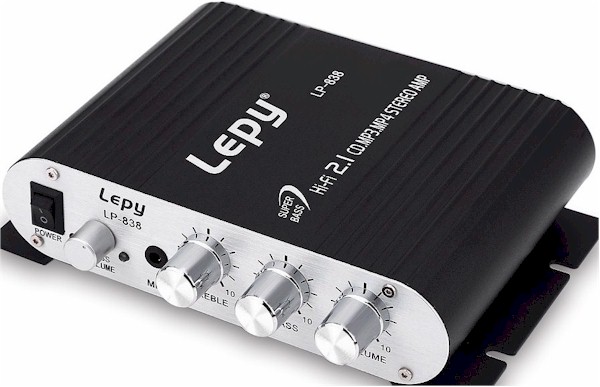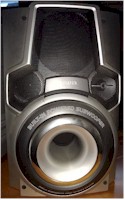 |
or "Everything that You Never Wanted to Know about the LP-838, 2.1 Amplifier" |
|
I recently acquired a number of speakers, and desiring to sell them as packages with an amplifier, purchased a "Lepy LP-838, 2.1 Amplifier" on eBay for around $25.00 (shipping included). I was interested to learn more about the amplifier (other than the sales hype) and went to Google to research. To my dismay, I could find almost NOTHING in terms of informed, authoritative and accurate information. I found a number of "audio enthusiast" forums where most of the "experts" are of the type that try to impress upon the readers their VAST expertise, experience and sophisticated insight by making groundless snide and disparaging remarks regarding the product, without providing the least iota of technical or objective information !! Primarily, ALL that I could learn was from the sales specifications: - All-aluminum and sand-blasting shell I was not able to find ANY information regarding the "inner workings" -- schematic, type of output transistors, configuration of the output power stage, circuit specs, user's guide, etc. About all that I was able to learn from my research was that it is (supposedly) a "cheap, Chinese knockoff" of the Lepai LP-2020 Tripath Amplifier that really made a big boom in the audio field back around 1996. They were apparently very well made and provided astonishing power and clarity for their size and cost. They are no longer manufactured (as such) since the company that made them went out of business in 2007, and they had the patent rights on the exclusive output technology called a "Tripath Amplifier" ( a patented Class D configuration). |
|
Class T was a registered trademark for a switching (class-D) audio amplifier, used for Tripath's amplifier technologies (patent filed on Jun 20, 1996). Similar designs have now been widely adopted by different manufacturers. The covered products use a class-D amplifier combined with proprietary techniques to control the pulse width modulation to produce what is claimed to be better performance than other class-D amplifier designs. Among the publicly disclosed differences is real time control of the switching frequency depending on the input signal and amplified output. One of the amplifiers, the TA2020, was named one of the twenty-five chips that 'shook the world" by the IEEE Spectrum magazine. The control signals in Class T amplifiers may be computed using digital signal processing or fully analog techniques. Currently available implementations use a loop similar to a higher order Delta-Sigma (or sigma-delta) modulator, with an internal digital clock to control the sample comparator. The two key aspects of this topology are that (1), feedback is taken directly from the switching node rather than the filtered output, and (2), the higher order loop provides much higher loop gain at high audio frequencies than would be possible in a conventional single pole amplifier. Financial difficulties caused Tripath to file for Chapter 11 bankruptcy protection on 8 February 2007. Tripath's stock and intellectual property were purchased later that year by Cirrus Logic. Read more on "Class D" amplifiers [ Here ] |
|
The "WEB buzz" is that the LP-838, on the other hand, is VERY poorly made with terrible quality control, and has no where near the sound quality of the original LP-2020. They are apparently manufactured by a huge Chinese operation that distributes them via numerous sources in various configurations under different brand names (two of them being Lepy and Lvpin). See this WEB Site [ Here ] |
|
Now by the laws of electrical science, power=V times A, or in THIS case 12x3=36 watts. In the REAL world (as opposed to that of advertising hype), you can NOT receive MORE that you give. That means that with a 36W power supply INPUTTING power, you can NOT get more than 36w OUT (and that would be at 100% efficiency, which is IMPOSSIBLE). In the face of this dilemma, we need to consider TWO points: (1.) Fortunately, an audio amplifier is not like a light bulb. If a light bulb is rated at 60W, that means that it draws 60W ALL the time that it is on (its power consumption does not vary). With an audio amplifier, however, its power consumption varies continuously depending upon the volume and tonal characteristics of what is being amplified. At any given moment, all three channels would rarely be called upon to deliver maximum power. As a matter of fact, while one channel may be delivering a large power burst, the other two may be quite idle. Therefore, the TOTAL power needs of the amplifier can remain relatively low.
|
|
Lacking ANY definitive help from my WEB search, I decided to disassemble one of the amplifiers and compile my own circuit specifications. This is what I found:
|
 |  |
Bottom line is, for a $25.00 amplifier, my testimony is that it is "VERY GOOD". It comes in a very attractive brushed aluminum housing (case) in either all silver or black and silver (see photos) with nice metal chrome knobs. The unit is sold packed in a retail cardboard box, usually without cables or PS (certainly at the $25.00 price that I paid). For what it is, it is a GREAT DEAL.
You may purchase one on eBay - Click [ Here ].
Also, you might be warned: If you lose the small green male connector for the center channel, you will NOT be able to find a replacment. You will need to take the amp apart and solder in some other type of connector. I did this on two amplifiers !! As far as I am concerned, most of the so-called, self proclaimed "critics and experts" on the WEB need to take a reality check. They remind me of the person who goes to McDonalds for a $5 hamburger and then complains that it doesn't even begin to compare to the meal that he had at the gourmet bristo that he dined at while in Paris. This is a $25.00 amplifier from China !!!! I saw a site reviewing the "Best Stereo Amps of 2020". Price wise, they ran from about $300 to $5,000 !! If you want quality, then buy one of those !! View [ Here ]. |







